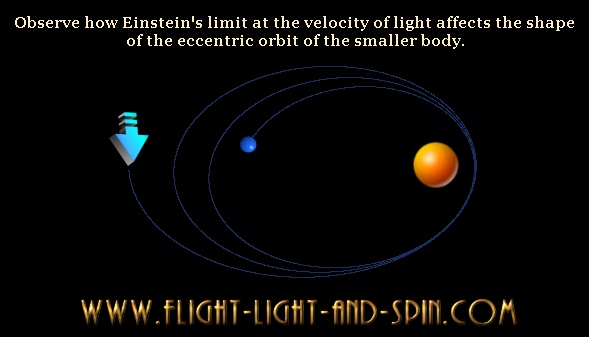Jonathan Ainsley Bain
Logical Positivist
See this link: How does Special Relativity Effect an Orbit?
This short article forms part of a much more complex set of astrophysics algorithms.
Before we can describe the entirety of effects of relativity on orbits, I would just like
to look at this one aspect. Has anyone ever noted this before?

If we consider just the formula for the reduction of velocity from special relativity:

... then it seems quite clear that any reduction of velocity away from Newton,
would result in an inwards spiral as the orbit loses expected velocity.
This would happen in a most pronounced way for eccentric orbits.
So for near-circular orbits like Venus, its a small adjustment, whereas for Mars and Mercury,
with high eccentricity, the amount is pronounced. But by how much?
For Mars, about 2/3rd of a km per orbit on average that Mars would be moving towards the Earth’s orbit
– if the limit at the velocity of light from Special Relativity causes a decrease in expected velocity.
For Mercury the in-spiral would be about 2km per orbit due to this loss in expected velocity:
Here is the link with more precise details: Relativity and planets orbits
So how do 'other aspects of relativity' allegedly compensate for this?
Well, the relativists would like to believe that there must be something to compensate for it.
But
there is not.
This link:Relativity Simulator Software
shows the software which was used to describe the various orbits evolving under the
various laws of gravity and astrophysics.
Cue: The non-programmer who claims he 'understands' because he uses jargon
instead of writing an algorithm of his own that APPLIES the formulae.
Praise to the Creator of all Creation!
This short article forms part of a much more complex set of astrophysics algorithms.
Before we can describe the entirety of effects of relativity on orbits, I would just like
to look at this one aspect. Has anyone ever noted this before?

If we consider just the formula for the reduction of velocity from special relativity:

... then it seems quite clear that any reduction of velocity away from Newton,
would result in an inwards spiral as the orbit loses expected velocity.
This would happen in a most pronounced way for eccentric orbits.
So for near-circular orbits like Venus, its a small adjustment, whereas for Mars and Mercury,
with high eccentricity, the amount is pronounced. But by how much?
For Mars, about 2/3rd of a km per orbit on average that Mars would be moving towards the Earth’s orbit
– if the limit at the velocity of light from Special Relativity causes a decrease in expected velocity.
For Mercury the in-spiral would be about 2km per orbit due to this loss in expected velocity:
Here is the link with more precise details: Relativity and planets orbits
So how do 'other aspects of relativity' allegedly compensate for this?
Well, the relativists would like to believe that there must be something to compensate for it.
But
there is not.
This link:Relativity Simulator Software
shows the software which was used to describe the various orbits evolving under the
various laws of gravity and astrophysics.
Cue: The non-programmer who claims he 'understands' because he uses jargon
instead of writing an algorithm of his own that APPLIES the formulae.
Praise to the Creator of all Creation!
